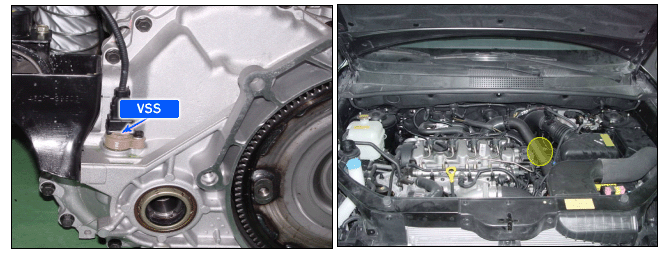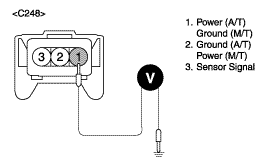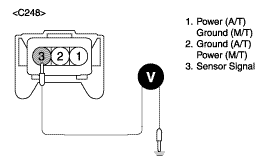Has a problem been found?

Repair as necessary and go to "Verification Vehicle Repair" procedure.

Go to "Power Circuit Inspection" procedure.

The VSS (Vehicle Speed Sensor) is a hall sensor type. The vehicle speed sensor is buit into the speedometer and converts the transaxle gear revolutions into the pulse signals, which are sent to ECM.
This pulse signal is fed to ECM to be used to determine the vehicle driving or stop condition including the vehicle speed.
The vehicle speed sensor provides ECM with information on the gear position in the manual transmission vehicle and on the gear shifting in the auto transaxle vehicle after computing the engine speed and the vehicle speed signal.
If the CMP signal is not geneated, the ECM judged this as a fault and DTC is set.
Item | Detecting Condition | Possible Cause |
DTC Strategy | ● Rationality check, high | ● Open or short in power circuit ● Open or short to ground in VSS cicuit ● Open in ground circuit ● Faulty VSS ● Faulty ECM |
Enable Conditions | ● In driving | |
Threshold Value | ● Vehicle speed signal > 220 Km/h | |
Diagnostic Time | ● 40 sec. | |
MIL Fuel Limit Fuel Cut EGR Off | ● No ● No ● No ● No | |
Fail safe | ● Clutch error monitoring deactivited ● Cruise control system and error monitoring deactivited ● Idle compensation deactivited in case of the lack of battery voltage |


Connect scantool to Data Link Cable (DLC).
Warm up engine to normal operating temperature.
Monitor "Engine Speed & Vehcle Speed Sensor" parameter on the scantool.

Fig 1) Vehicle speed normal value with engine speed 3550 rpm during driving.
Is the Current data displayed correctly ?

▶ Fault is intermittent caused by poor contact in the sensor’s and/or ECM’s connector or was repaired and ECM memory was not cleared. Thoroughly check connectors for looseness, poor connection, bending, corrosion, contamination, deterioration, or damage. Repair or replace as necessary and go to "Verification of Vehicle Repair" procedure.

▶ Go to "W/Harness Inspection" procedure.
Many malfunctions in the electrical system are caused by poor harness and terminals.
Faults can also be caused by interference from other electrical systems, and mechanical or chemical damage.
Thoroughly check connectors for looseness, poor connection, bending, corrosion, contamination, deterioration, or damage.
Has a problem been found?

Repair as necessary and go to "Verification Vehicle Repair" procedure.

Go to "Power Circuit Inspection" procedure.
Ignition "OFF" & Engine "OFF".
Disconnect VS sensor connector.
Ignition "ON" & Engine "OFF".
Measure voltage between terminal 1(A/T) or 2(M/T) of the VSS harness connector and chassis ground.
Specification : Approx. B+

Is the measured voltage within specifications ?

▶ Go to "Signal Circuit Inspection" procedure.

▶ Check for open or short in power harness.
Repair as necessary and go to "Verification is Vehicle Repair" procedure.
Ignition "OFF" & Engine "OFF".
Disconnect VS sensor connector.
Measure voltage between terminal 3 of VSS harness connector and chassis ground
Specification : Approx. 12V

Is the measuered voltage within specifications ?

▶ Go to "Ground Circuit Inspection" procedure.

▶ Check for open or short to ground in harness.
Repair as necessary and go to "Verification of Vehicle Repair" procedure.
Ignition "OFF" & Engine "OFF".
Disconnect VS sensor and ECM connector.
Measure resistance between terminal 2(A/T) or (M/T) of VSS harness connector and terminal 49 of ECM harness connector.
Specification : Approx. below 1Ω

Is the measured resistance within specifications ?

▶ Go to "Component Inspection" procedure.

▶ Check for open in harness.
Repair as necessary and go to "Verification of Vehicle Repair" procedure.
Ignition "OFF" & Engine "OFF".
Disconnect VSS connector.
Remove VSS and Driven gear from Transaxle.
Visually check that VSS driven gear is in good condition.
Monitor signal waveform by rotating VSS driven gear with hand after connect connector to VSS.
Is signal waveform generated from VSS ?

▶ Substitute with a known-good ECM and check for proper operation.
If the problem is corrected, replace ECM and then go to "Verification of Vehicle Repair" procedure.

▶ Check VSS for contamination, deterioration, or damage. Substitute with a known-good.
VSS and check for proper operation. If the problem is corrected, replace VSS and then go to "Verification of Vehicle Repair" procedure.
After a repair, it is essential to verify that the fault has been corrected.
Connect scan tool and select "Diagnostic Trouble Codes(DTCs)" mode and then clear DTC.
Operate the vehicle within DTC Enable conditions in General information.
Are any DTCs present ?

Go to the applicable troubleshooting procedure.

System is performing to specification at this time.